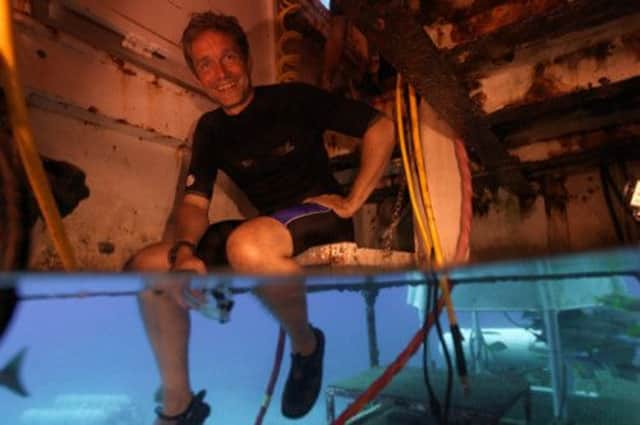Cousteau family aims for underwater record books


If he succeeds he will beat the 30-day underwater living record set 50 years ago in the Red Sea by his scuba-pioneering grandfather, Jacques-Yves Cousteau.
“We’re doing something unprecedented,” said Fabien, 45, who grew up on the decks of his grandfather’s ships, Calypso and Alcyone. “It’s the risk of discovery, it’s the curiosity, it’s the adventure. It’s going beyond that box that we always live in and are comfortable with, to learn something new.”
Advertisement
Hide AdAdvertisement
Hide AdWhile submerged under the Atlantic, Fabien Cousteau and his five-person team plan to Skype with children in classrooms around the world, make a 3D Imax documentary, measure the effects of underwater living on their own bodies, count the fish and chart the pollution levels in the surrounding waters, experiment with coral-growing techniques and test the newest underwater motorcycles. They also hope to arrange a chat with astronauts living aboard the International Space Station.
“It’ll be a packed schedule,” said Mr Cousteau. “This is a huge endeavour and we definitely need to take advantage as much as possible.”
The Mission 31 team members plan to submerge on 30 September and resurface on Halloween from the Aquarius habitat in the Florida Keys National Marine Sanctuary.
The cylindrical 43-foot laboratory sits on a patch of sand near some deep coral reefs about nine miles south of Key Largo.
It is owned by the US National Oceanic and Atmospheric Administration (NOAA) and run by Florida International University. Nasa has used it to train astronauts for the isolation and weightlessness of space.
Aquarius is the last undersea laboratory still operating – “the best-kept secret in the oceans,” Mr Cousteau said. Dozens of others around the world have been mothballed due to high costs.
Aquarius has six bunks and a bathroom with shower, and is air-conditioned. Portholes give the occupants a 24-hour view of the abundant marine life. The living space is at a depth of 50 to 60 feet, where the atmospheric pressure is roughly 2.5 to three times that at the surface.
Undersea pressure causes divers’ bodies to absorb more nitrogen, oxygen and other inert gases than they would at sea level. When surfacing, they must ascend slowly and stop at regular intervals to allow the extra gases to dissipate, or risk the formation of potentially deadly bubbles in the blood and tissue, known as decompression sickness or “the bends”.
Advertisement
Hide AdAdvertisement
Hide AdBut research has shown that once their bodies are saturated with the maximum amount of gas it is possible to absorb at a particular depth, the length of time it takes to safely decompress stays the same no matter how long they stay under.
Aquarius residents can dive around outside for six to nine hours a day without decompressing, compared with a limit of about an hour for divers working from the surface, because they stay underwater after the dive ends. “We get to see things in the way you would if you were immersed like a fish,” Mr Cousteau said.
When the mission ends, the pressure inside Aquarius will be lowered until it equals that on the surface, allowing the divers to decompress inside the lab and then swim to the surface.
Mr Cousteau’s grandfather, who died in 1997, first demonstrated that such “saturation diving” could be done safely when he spent 30 days in an underwater habitat in the Red Sea off Sudan in 1963, chronicled in Oscar-winning documentary World Without Sun.
“We’re going one day longer to make the point,” Fabien Cousteau said. “We’re doing it twice as deep and we’re going farther in terms of our ocean walks.”